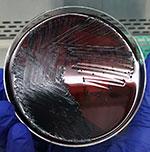Residency Program - Case of the Month
June 2018 - Presented by Andrew D. Jones, MD; Ellen Papathakis, CLS; Anna M. Romanelli, PhD.
Clinical History
A fully vaccinated 14-year-old girl with no significant medical history presented to our institution with a history of progressive decline. Ten days prior to admission, she experienced vague abdominal pain, followed by a sore throat. She developed chest pain, and after experiencing a fall, was found to have altered mental status with speech difficulties. She presented to an outside institution where she was found to be febrile, and a head CT was concerning for stroke. She was started on empiric antibiotics and emergently transferred to UC Davis.
Upon arrival, an MRA demonstrated multiple infarcts in the area of the left middle cerebral artery. Physical exam was notable for a new systolic murmur; imaging demonstrated mitral regurgitation with possible valvular vegetation. Janeway lesions were identified on her bilateral soles.
Results from blood and CSF cultures from the outside institution were obtained, which showed no growth. On hospital day 3, an admission blood culture was found to be positive, and Gram stain revealed Gram positive rods. By hospital day 4, one culture plate was growing the organism shown below (images 1 and 2).
Click on images to enlarge.
Image 1: This image shows the blood agar and chocolate plates (bottom) with gray-white colony morphology. The CTA plate (middle) shows the typical black morphology characteristic of this organism. From left to right, the biochemical tests include CTA base control (organism growth positive); Dextrose acid (positive); Maltose acid (positive); Sucrose (negative); Nitrate reduction (positive); Urea (negative).
The organism is a Gram-positive bacillus with mild pleomorphism. Laboratory workup showed it to be non-spore forming, non-acid fast, non-motile, and catalase positive. On sheep blood agar (SBA), the isolated organism shows white to off-white, flat colonies. Chocolate agar shows similar morphology. The organism ferments dextrose and maltose and reduces nitrate, but had no reaction with sucrose and urea. When plated on a cystine tryptic agar (CTA), dry black colonies grew.
Which of the following is the best identification of this organism?
Choose one answer and submit.



 Meet our Residency Program Director
Meet our Residency Program Director
